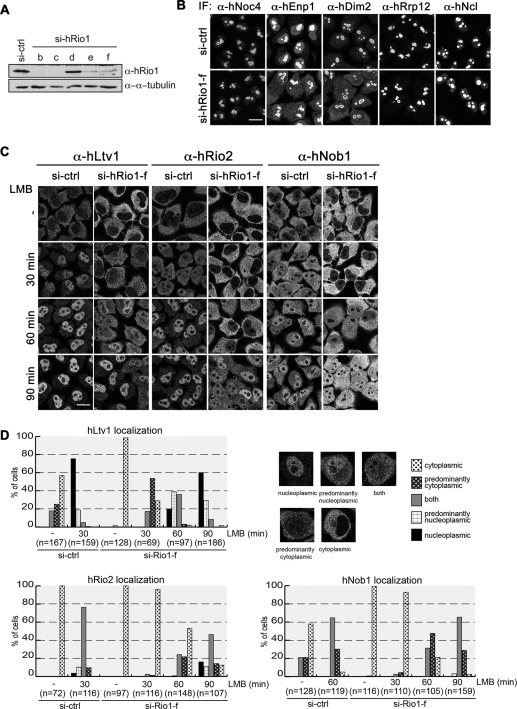FIGURE 3:
hRio1 is required for the cytoplasmic release of 40S trans-acting factors. (A) HeLa cells were transfected with five different siRNAs (17.5 nM) targeting hRio1. Cells were harvested after 3 d, and down-regulation of hRio1 was analyzed by Western blotting. For further analysis, the siRNA Rio1-f was chosen, as it targets the 3′UTR of the mRNA and allows for rescue experiments. (B) hRio1 was depleted from HeLa cells using si-Rio1-f as in A. Cells were fixed, and the localization of different nucleolar 40S trans-acting factors was analyzed by immunofluorescence. Whereas hDim2 and hEnp1 accumulated in the cytoplasm after depletion of hRio1, localization of nucleolin (hNcl), hNoc4, and hRrp12 was not altered. Scale bar, 20 μm. (C) Cells were depleted of hRio1 as in B. Before fixation, cells were treated with 20 nM LMB or ethanol (-) for the indicated times. Localization of hLtv1, hRio2, and hNob1 was analyzed by immunofluorescence. Scale bar, 20 μm. (D) Quantification of experiment shown in C. Based on the localization of the trans-acting factors, cells were assigned to the following phenotypic classes: cytoplasmic, predominantly cytoplasmic, both (equal cytoplasmic and nuclear localization), predominantly nucleoplasmic, and nucleoplasmic. Example cells are shown for hLtv1 localization. hLtv1 and hRio2 accumulate in the nucleus 30 and 60 min after inhibition of hCrm1, respectively. However, upon depletion of hRio1, their shuttling kinetics are delayed, indicating defects in recycling of both factors from pre-40S. hNob1 shuttling, although slower than shuttling of hLtv1 and hRio2 in control cells, is further delayed upon knockdown of hRio1.

